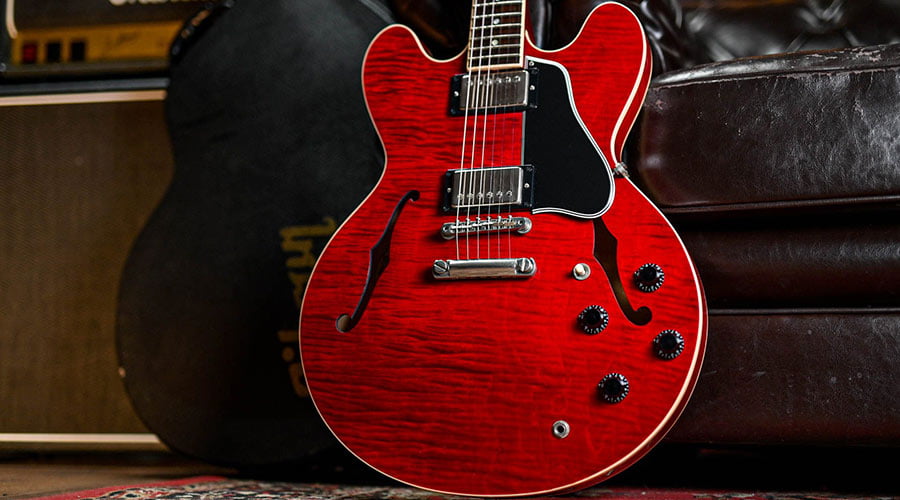
They say to never work with children or animals. Well, what about cars and guitars?
In the 1985 movie, “Back to the Future”, Michael J Fox went toe to toe with a time-traveling car and a Gibson ES-345. Despite putting in a performance that made him a star, he was always going to fall short against a time-traveling DeLorean! To this day when a DeLorean goes past, it will turn heads.
Exactly like the ES guitar.
Who doesn’t do a double take when they see a cherry red, Gibson ES-335? Everybody remembers Marty’s raucous rendition of “Johnny B Goode”, channeling his inner Van Halen to a crowd of stunned 1950s teenagers.
Many of us fell in love with the guitar the day we watched Marty McFly shredding on the 345. So, in a film that is jam-packed with memorable moments, what is it about this guitar that continues to inspire such fond memories? Let’s have a look.
History
Looking back from our vantage point, the 1950s seemed like a time when Gibson was working miracles. The Les Paul, The Flying V, The Explorer, not to mention the PAF pickups, and the tune-o-matic bridge; they could do no wrong. But despite all these innovations Fender seemed to always be one step ahead of the guys in Kalamazoo.
The first mass-produced solidbody electric guitar, the Telecaster arrived in 1952, initially to great skepticism, but it went on to sell in large numbers. Gibson had been approached by Les Paul as early as 1942 with the homemade electric guitar he’d christened the “Log”. They could have beaten Fender by a decade, but they dismissed his idea as “a broomstick with pickups”. When they finally got around to creating the Les Paul Model, Fender was moving on to the Stratocaster and the single cut-away Les Paul was already looking old-fashioned.
By 1958 the sales of the Les Paul had started to go into a steep decline, whilst the sales of Gibson’s thinline hollowbody guitars such as the Byrdland and the ES-225T had been steadily rising. The numbers men at Gibson could be forgiven for thinking that the solidbody was on its way out and that thinlines were the future.
With this in mind, they set about designing a brand-new model, this time they wouldn’t be reacting to Fender’s latest design but would draw upon all the various ideas that had been successful in their solidbody electrics up to that point. This time they would be the ones out in front with a Gibson design.
The Gibson ES-335
The Electric Spanish (ES) 335 was designed by the tnen Gibson President Ted McCarty and a team of engineers, led by Larry Allers. From the Les Paul, they took the electronic layout, the twin PAF humbucking pickups, the ABR-1 adjustable bridge, and the stop-bar tailpiece. They took the thinline hollow construction from the Byrdland, ES-225T and the double-cutaway came from the new Les Paul Special design.
When the guitar was first announced in 1958, the Gibson Gazette magazine described it as “Chameleon-like”, and it was. What truly separates the ES-335 from the instruments that it drew its inspiration from, is the center block.
Up until this point, the hollow-body electric guitar had one major drawback: it tended to feedback at higher volumes. This made it difficult for performers to keep them under control. What Ted McCarty came up with was revolutionary. He decided to add a solid block of maple that ran through the center of the guitar, this block gave the guitar the feedback-canceling qualities of the Les Paul but with a new semi-hollow construction.
When the Gibson ES-335 debuted in March 1958, the original color options available were the ES-335TN for “Thinline Natural”, and ES-335T which was the Sunburst model. The list price was $282.50 and $267.50 respectively. By the time the 335 appeared at the 1958 NAMM show in July, a “D” had been added to the model name, so the ES-335TN was now the ES-335TDN the letters stood for “Electric Spanish-335 Thin Double-Pickup Natural”.
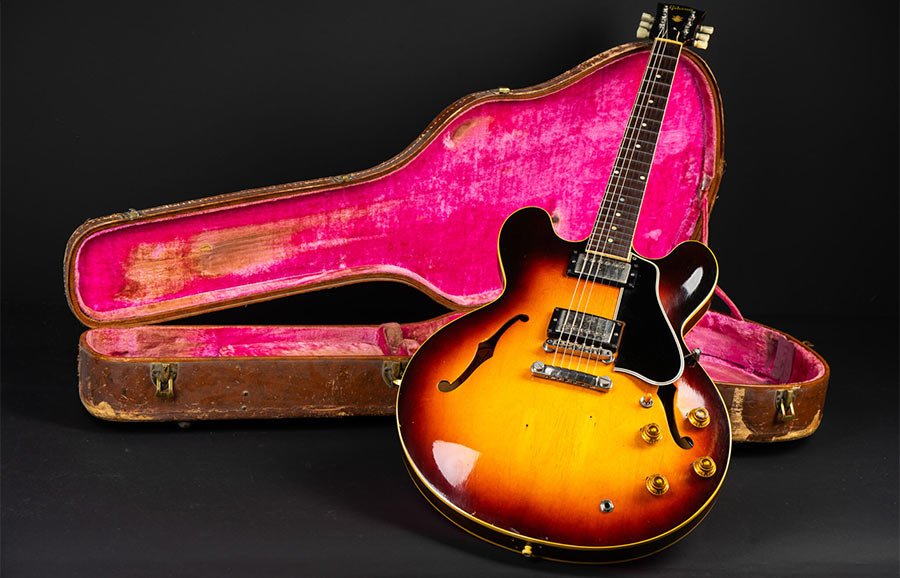
Construction
The 335 body has a 3-ply laminate construction that consists of 2 layers of maple with a middle layer of poplar. The 3 pieces are glued together and then pressed into shape to form the archtop design.
The sides of the instrument are also laminated and are similarly pressed into shape. The original design featured a single piece of mahogany that formed the neck and the headstock with the 2 “wings” added to complete the open-book style head, and a single piece of Brazilian rosewood was used for the fretboard.
The first models used Vintage Fret Wire; this was thin but in 1959 Gibson switched to Jumbo Fret Wire. The neck joined the body at the 19th fret giving the player complete access to every fret.
The inside of the guitar features the maple center block as well as strips of spruce called counter bracing. Unlike the Les Paul, there is no access panel for the electronics, the only way into the guitar is through the f-holes.
As far as the hardware goes, the ES-335 has 2 humbuckers with the usual 3-way switch, and 2 volume and 2 tone knobs. The original ES models came with the legendary patent applied for pickups, part of the enduring appeal of these guitars.
Finally, the strings were anchored to the body using the same stop-bar tailpiece that could be found on the Les Paul Model, although in 1965 they swapped it for a trapeze-style tailpiece. Despite this, it is still the stop-bar/abr-1 that is most commonly found on ES-335 guitars. It was even possible to forego the tailpiece entirely and have a factory-fitted Bigsby vibrato unit.
The 2 cutaways or “ears” as they are now called, were originally a more rounded silhouette from 1958-1963. They are affectionately known as “Mickey Mouse” ears, and from 1963 they became slightly sharper. The original shape is generally the more desirable of the two.
In 1961 they introduced the sideways Vibrola system. This was an attractive design that changed the pitch of the string by moving two large springs in the unit with a side arm. Unfortunately, the strings would rarely return to pitch. In 1963 they changed the unit to an up and down, Deluxe Vibrola. This unit was also problematic, and it was later replaced with the original Bigsby vibrato.
The enduring appeal of the ES-335 has meant the construction of the guitar has largely stayed true to the original design from 1958 to this day, with the years 1959-1964 generally considered the best.
You may be curious as to what it is about this design that has made it one of the longest-continuous production electric guitars ever?
What makes the ES-335 special?
Looks
The 335 is one of the all-time classic designs. From its elegant f-holes to its beautiful curves, it has always been a guitar that commands attention.
Whether it is the 1950s dot inlay, “Mickey Mouse” ears look, or the 1960s block inlays and the slightly sharper ears, if you want to stand out and sound fantastic, then you could do a lot worse than an ES-335.
Sound
The semi-hollow construction of the ES-335 means the sound of the instrument is unique. It has been called the most versatile of all the electric guitars.
The 335 is an equal blend of a roaring rock beast and gentle jazz machine, it is perfectly at home in pretty much any genre: country, blues, jazz, rock, and fusion. You will often see the sound of the guitar described as woody, airy, or mellow.
Things like sound are very difficult to quantify but if you think of a slightly lower output Les Paul, with a little less attack and a more open sound, you won’t be far off.
Application
The word that comes to mind when describing the iconic semi-hollowbody, is versatility. Because the guitar is semi-hollow, it can be prone to feedback at higher volumes. For some players, this is a drawback but for the 335 aficionado, it is exactly what separates it from the pack. In the hands of someone who knows how to control it, the endless amounts of sustain and note-bloom can be breathtaking.
Don’t be put off by this though. If you think that an ES-335 can’t handle high volumes, then you only need to look at guys like Dave Grohl and Eric Clapton. There is nothing you can throw at it that it can’t handle.
Still not convinced? Then allow American guitarist, Larry Carlton, to have the last word:
“I love jazz, I can play rock and roll and I can play country music, so I was looking for a guitar that could cover all those bags. I needed a guitar that was-and is-as versatile in sound as I was as a player. After checking out a few things, I decided that the Gibson ES-335 was right for me. I could play my jazz things – I love jazz and I love the f-hole and the semi-hollow body sound – but when you put on the treble pickup, you can get it to scream on the amplifier. Versatility, versatility, versatility – that’s why I chose this guitar.”
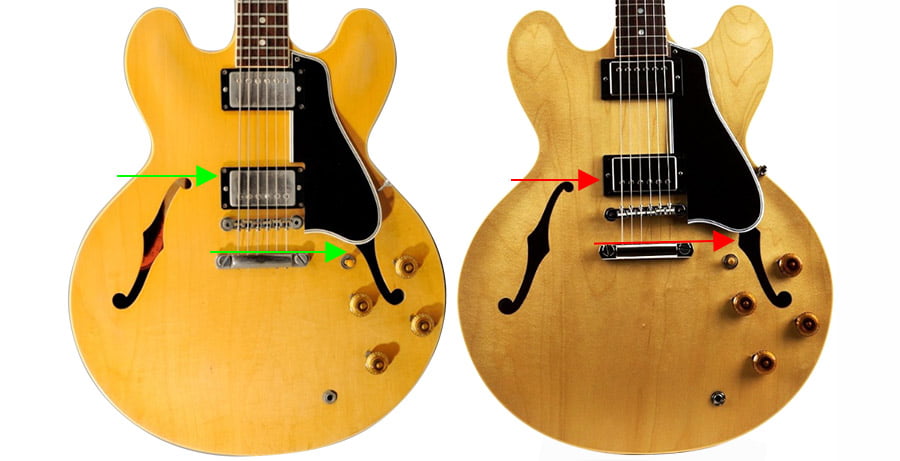
ES Series Models
Epiphone ES-335
This is the Epiphone version of the Gibson original. Made in China, as a subsidiary of the Gibson brand, it is as close to its big brother as it can be without the steep price tag. The latest version is from the ‘Inspired by Gibson’ range. This means the guitar is faithful to the original design and construction of the 335 but with a few changes that help to keep the costs down.
The Epi has a laminated, pressed 3-ply maple body with a maple center block and a mahogany neck, just like the Gibson. The fretboard is made of Indian Laurel, an increasingly popular rosewood substitute found on import guitars, and both neck and body are bound.
So, what is the difference?
Firstly, being made in China, the costs of labor are significantly less – there’s just no getting around it. Secondly, the materials are of a lesser grade than the USA-made Gibson. That’s not to say they are bad but on average less care will have been taken when selecting the wood used. Third, the quality of the electrics will not be comparable to the Gibson.
However, in recent years, especially with the ‘Inspired By’ models the quality of the pickups and hardware on Epiphones have improved dramatically, but they are still lacking compared to a bona fide Gibson 335.
Lastly, the Epiphone will be finished in a polyurethane lacquer. This is a harder-wearing, more cost-effective finish compared to the traditional nitro finish that Gibson uses. Some players swear that only nitro allows the guitar to “breathe” and that poly effectively encases the instrument in a plastic coating. Can anyone truly hear a polyurethane finish at playing volumes? It’s doubtful.
Editor’s Note: When new, a guitar with nitro and poly may not be noticeable right away, but that will change as over time, especially for nitro finishes. As they age, the wood covered with the nitro finish will continue to evaporate microscopic moisture. The poly finish, on the other hand, just traps the moisture. That is why vintage guitars can have a better overall sound due to the wood drying and being able to reverberate more.
Despite these relatively modest compromises the Epiphone represents, they still offer phenomenal value and a great playing experience. So just how much better is a Gibson ES-335? The answer is probably not as much as the price difference would suggest.
An Epiphone ES-335 currently costs around $600/£470 whilst the cheapest Gibson comes in at $3,000/£2599, so is it 5 times better? Absolutely not. I’m not even sure it is twice as good but clearly, there is a difference in quality between the two instruments.
Whether the difference in cost is worth it will depend on the individual. Are you an at-home player who wants to have a good facsimile of Chuck Berry’s guitar so you can duck-walk in front of the mirror? Then the Epiphone will do everything you need.
Maybe you are someone who plays regular gigs, and you want to have something that will sound great every night and is reliable, then you might want the Gibson.
If you are serious about getting a 335, please don’t take my word for it go and try them both and let the guitar do the talking.
Gibson ES-335
This is the current iteration of the classic 335. It is pretty much as it was in 1958: 3-ply maple/poplar top and back, mahogany neck, and rosewood fingerboard. The controls are the same 2 volumes, 2 tones, and 1 toggle switch to operate the pickups.
The pickups themselves are the new reimagining of the 1970s T-Tops. The hardware is a nickel abr-1 bridge and the classic stop-bar tailpiece.
All this can be had for $3,499/£3399. If you want to save a few bucks the satin finished 335 dot is available for $3,000/£2599, or if you fancy a figured top, that’ll skin you $4,000/£3799.
Gibson ES-345
This is a traditional 335 but with a little bit of added bling. Instead of the dot inlays, you get double-parallelograms and multi-ply binding on the body instead of the usual single-ply.
When the 345 first appeared in 1959 it was hailed as a “New and first from Gibson…true stereophonic sound for the guitar”. This was achieved by using a Y-cable and stereo wiring in the output jack. In addition to this, the 345 also came with a “Varitone” switch. This was a 6-position switch that offered the user 6 different sound presets at the flick, or a twist in this case, of a switch. Technically it was an attenuator that would remove different sound frequencies at each setting.
Both “upgrades” remain controversial to this day. Some players enjoy the variety of sounds the stereo wiring and Varitone offer, whilst many feel the Varitone changes the tone of the guitar even when it is set on the off position. In the end, a lot of players had the guitar rewired to standard wiring and disconnected the Varitone.
The modern version has removed it entirely. It is available for $3,799/£3299.
Gibson ES-355
The 355 is the top-of-the-line semi-hollow Gibson, the equivalent of the Les Paul Custom. This guitar has the classic, split diamond headstock inlay and multi-ply binding on the front, back, and headstock. It comes with an ebony fretboard, block inlays, and gold hardware. It is undoubtedly a striking guitar.
The current production model is the Gibson Custom 1959 reissue Murphy Lab lightly aged. This is a custom shop model that has been lightly aged to look like a well-looked-after 1959, showing just a little wear and tear.
Naturally, all this comes at a premium. $8,699/£7389 to be exact, but if only the best will do then this is it.
Gibson ES-330
The odd one out in the 335 family, is the ES-330. The body is the same size with the same laminate construction, mahogany neck, and rosewood fingerboard as the 335 but it has 3 fundamental differences.
The biggest one is the absence of a center block, meaning that the 330 is a completely hollow guitar. This gives the instrument a unique tone and, of course, makes it even more of a challenge to contain feedback. The 330 is fitted with 2 P90 pickups and in the absence of a center block, it has a trapeze-style tailpiece.
The final change made to the 330 was the position of the neck in relation to the body. The neck joins at the 17th fret, as opposed to the 22nd on the 335. Gibson does currently offer a production model but there are plenty on the used market.
Alternatively, the USA-made Epiphone Casino is available for around $3,499/£2869.
Gibson ES-339
First released in 2007, the ES-339 is basically a 335 but with a smaller body. One of the most common complaints against the 335 is its size. While it is a well-balanced instrument, it is considerably larger than a Strat or a Les Paul.
The 339 will get you the same great sound and looks but without the bulk. It has the same construction, same electronics, and twin humbuckers, 57 classics to be precise. Truly it just comes down to personal preference.
If a more streamlined semi is something that appeals to you, then they are currently retailing at $3,499/£2799.
ES-335 Maintenance
For some reason, people who can play guitar seem to have trouble with leaving the instrument alone. If it isn’t glued in place, then chances are that the day will come when you are looking down at your prized 6-string, with a screwdriver in hand, thinking if I just take those pickups off or maybe I’ll adjust the bridge a little.
We have all been there, and once you start tinkering then you can never stop. I am not here to cast aspersions, sometimes a well-judged upgrade can revitalize a tired instrument. Unfortunately, with a semi-hollow type guitar, it is very easy to end up biting off more than you can chew.
Well, fear not! If you are the type of person who can’t help pulling things apart then we’ve got your back.
General Care
The thing about guitars is, once they are set up, they do not need much maintenance. They are meant to be played, not messed with. That said, when it is time for a new set of strings, it doesn’t hurt to do a quick check on a couple of things.
- The nut. A little lubricant in the nut slots will help tuning stability, which is especially important on a Gibson-style, 3-on-each-side headstock. You can buy special nut lubricant products or simply use graphite from a pencil. Either one will do the job.
- Give it a good clean. You can buy a guitar cleaner/polish, then use a microfiber cloth and give it a gentle rub down. The fretboard is an area that can get particularly grimy if neglected. Years of built-up crud on your fretboard isn’t mojo, it’s disgusting. Get it cleaned.
- The fretboard. The ES-335 most commonly has a rosewood board. These will dry out over time, so once or twice a year a little lemon oil will bring back its luster. Not too much, though, you don’t need to drown it.
- The bridge. Check the saddles for any dirt that may affect intonation, and give it a clean, but if it looks good and your guitar is well intonated, then don’t mess with it. You know the saying: if it ain’t broke, don’t fix it.
- Check for neck relief. This is another one that doesn’t need doing very often. Once, maybe twice a year, have a look to see if the truss rod needs adjusting. Place a capo on the first fret, and then fret the string where the neck meets the body. Have a look at the gap between the strings and the fretboard around the 8th fret. What you want is a slight gap, the neck should have a slight curve away from the strings. If it is curving up, then it has a back bow, and the truss rod needs loosening. If it has too big a gap, then it needs tightening. Some people like a straight neck, it is ultimately a personal preference. A good way is to start with the recommended Gibson specs of between 10 and 12 thousand of an inch (0.01 & 0.012-inch/0.254 & 0.3048mm), then decide if you like it with more or less relief. Looking down from the headstock to the bridge, remove the truss rod cover and turn the adjusting tool right to tighten and left to loosen. A quarter of a turn at a time, no more! Then allow the neck to settle, and play a bit before making any more adjustments. This is particularly important when tightening so you won’t hurt your guitar if you loosen it too much, but you can destroy a truss rod by overtightening.
Upgrades
There are a million reasons why we like to change parts on our guitars. Some of us can’t afford the outlay on a USA guitar, so we buy the Epiphone and put some nicer parts on it and still save a couple of grand. Some of us just can’t help but mess with stuff, it doesn’t matter – most of us will do it at some point.
The thing with a semi-hollow body is that there is no access plate like in a Les Paul. The only way in or out is through those f-holes, which can be an almighty pain in the backside. The key is to plan ahead.
Make a template on a piece of card showing the layout of the volume and tone controls, and the position of the switch and the output jack. You can attach everything to it when you remove them, that way they won’t get tangled up. Get some surgical tubing or some strong fishing line that you attach to the shaft of the pots, this will allow you to pull them back through the holes when they are ready to go back in.
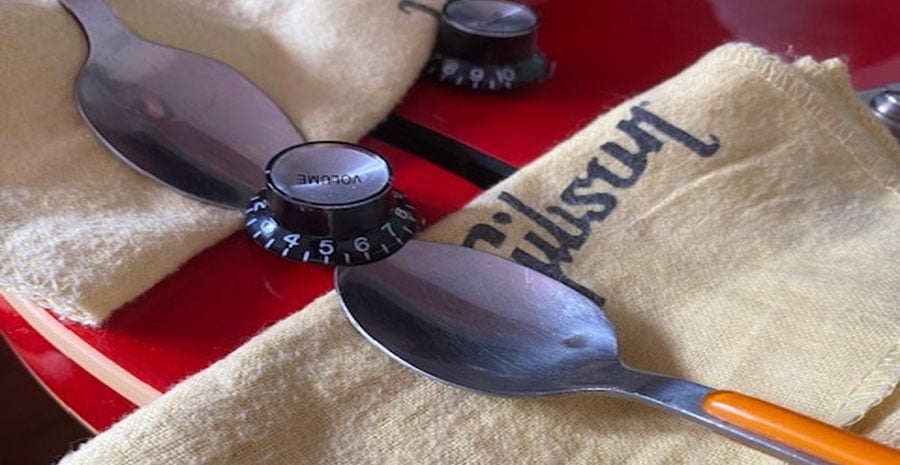
- If it is just a pickup swap, you must remove all the electronics. First of all, remove the knobs from the pots, you can use two teaspoons, one on each side of the knob to lever it off. Be careful not to damage the guitar’s finish always cover it with a soft cloth and be gentle!
- Next, attach the tubing or fishing line to the exposed shaft of each pot. Don’t forget the switch. Make sure it is long enough that you can completely remove all the electrics, and have enough room to work on them while they are still attached with the wire/tubing. Then pull the nuts and washers over the tubing/wire, and let the pots drop into the guitar. For the output jack, the best way is to buy a body-less jack cable that you can plug in and that can be used to anchor the socket. Unscrew the nut and washer and pull them back over the cable, and then allow the socket to fall into the guitar.
- Carefully unscrew the pickups. Again, be careful not to scratch the guitar finish, always cover the instrument with a cloth. Trust me, there will very likely come a time after several hours when you are thinking “f#k it!, I just want to finish this s*t!” and you will not be thinking of the finish. That moment will pass but the scratches will last forever. Once unscrewed, drop them into the cavity.
- You can now remove the wire harness and the pickups. This must come through the f-hole, and it can be a real test of mental fortitude, but not as much as putting the stuff back in. Attach it all to the card template you have made (you have made it right?). It will stop it from becoming a spaghetti junction, and when you put it all back in, you’ll know what goes where.
- First of all, take some pictures of the wiring. You might think you’ll remember, but you probably won’t. While the nice diagram below looks so clear, the mess of wires in front of you might not. So, take some pictures. Then unsolder the old pickups from the pots and solder on the new ones.
- At this point, you’ll be desperate to put it all back in, but cool your jets, plug it in first. Tap on the pickups and try them. You don’t want to have it put back together only to find out you’ve got a dodgy connection. If you are changing the selector switch, then check that too.
- Ok, now the fun part. Just put it all back in, simple. Use the tubing or wire to pull it back through the holes, this is where the tubing will pay dividends. The wire will pull the shaft to the hole but not through and you will have to play around with it to get the end to pull through. The tubing goes over the end, so it will take it straight through. Just be patient, don’t let your frustration boil over. You can do it.
- Now you can replace the washers and the nuts on the pots, the output jack, and the switch and tighten them all in place. Use your fingers to pull the pickups through and screw them back on. Re-string and off you go!
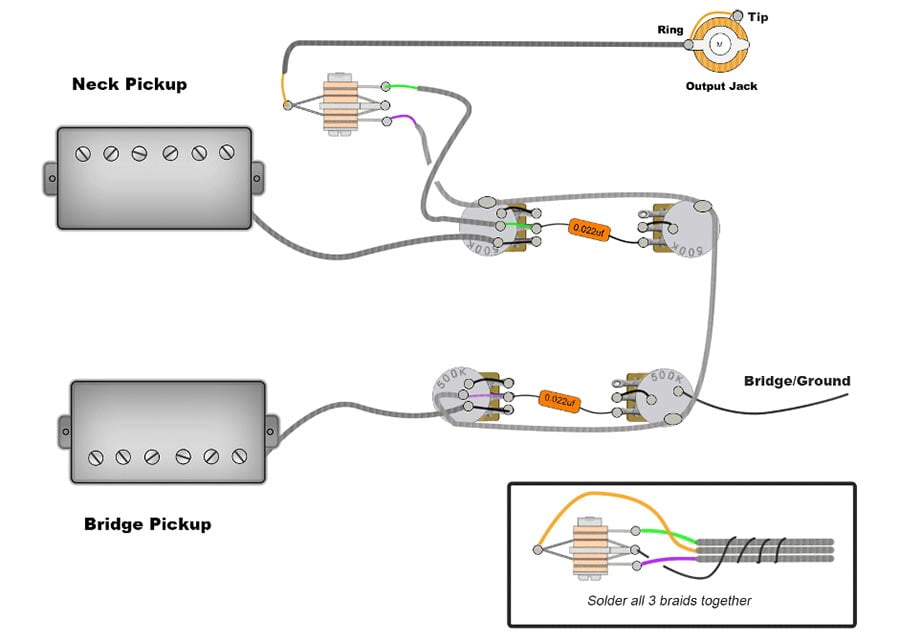
If you choose to replace everything, then I recommend investing in a pre-soldered wiring harness. They will come in a pre-made template, and you can simply solder your pickups on and jump straight to Step 6 above. If you are really brave, you can do it all from scratch, in which case the diagram above is your bible. Good luck!
Notable ES-335 Players
BB King
The king of the blues has had a few ES guitars, including the current Gibson custom shop BB King “Live at the Regal” 335. But he is most famous for “Lucille”, an ebony ES-355 but without f-holes.
The story goes that BB was playing a gig in Arkansas in the mid-1950s when two men started fighting and knocked over a barrel that was burning kerosene. It was common at the time to heat dance halls in this way. But, of course, it was also dangerous, and the building caught fire.
When King realized he had left his guitar inside, he ran back in and retrieved it from the blaze. He subsequently learned that the two men had been fighting over a woman named Lucille. So, he named the guitar “Lucille” and continued to name all of his guitars from that day on as a reminder never to fight over a woman.
In 1980, Gibson created the BB King Lucille model. This was essentially an ES-355 without f-holes in full stereo and with the Varitone switch, of which King was a big proponent. Despite some changes over the years, this model has been in constant production ever since.
If you want to hear the man himself at his peak, then the aforementioned “Live at the Regal” is the quintessential BB King album. If you haven’t already, then listen to “The Thrill is Gone”. It doesn’t get much cooler.
Chuck Berry
The “Father of Rock and Roll” is well known for his use of Gibson ES-type guitars, but he is most famous for three in particular. His 1955 ES-350T that he named “Maybellene” was the guitar he used to record all his early hits. When he combined this with 8-gauge banjo strings he was able to create the bends and double-stops that are the sound of rock and roll.
Next up is his 1978 ES-355. Berry continued touring throughout his life, right into his 80s and he would often be seen with his wine red 355. In 2021, Gibson produced a Murphy Lab limited edition recreation of this guitar. Only 100 instruments were produced and were soon snapped up, proving the man who started it all still has a loyal fanbase.
Finally, his 1958 Gibson ES-355. He fell in love with his cherry-red 355 and he used it until the day he died. When you think of Chuck Berry, it is with this guitar, playing Johnny B Goode and doing the duck walk. He loved this guitar so much that when he passed away in 2017, he was buried with it.
Larry Carlton
If you aren’t a guitarist, you may well ask “Who is Larry Carlton?” A quick look at some of the artists he has recorded with will leave you in no doubt as to the stature of the man. Steely Dan, Michael Jackson, Dolly Parton, and Joni Mitchell are but a few. He has been featured on some of the most important recordings of the last 50 years, and he did it all with his trusty Gibson ES-335.
He is best known as a consummate session player, adding guitar parts in all different genres. His devotion to the 335 was down to the versatility of the instrument. It allowed him to play in any number of different styles without having to change guitar. Indeed, he would become so closely associated with the 335 that he became known as Mr. 335.
Check out his work with Steely Dan on their album “The Royal Scam”.
Conclusion
What else can you say about the ES-335? Putting aside the great people who played them, it is an icon in its own right. More than any other guitar, it symbolizes rock and roll, so much so when Robert Zemeckis needed a guitar for Marty McFly to play with, it had to be the cherry-red ES-345.
Even though the guitar had to do some time traveling of its own, the 345 model was introduced in 1958, three years after the time that the film was set. But we can forgive that because it is just so perfect.
When you add in the players, the songs, and the concerts that this guitar was used in, then it is fair to say it deserves its place in history as one of the most important guitar designs ever.
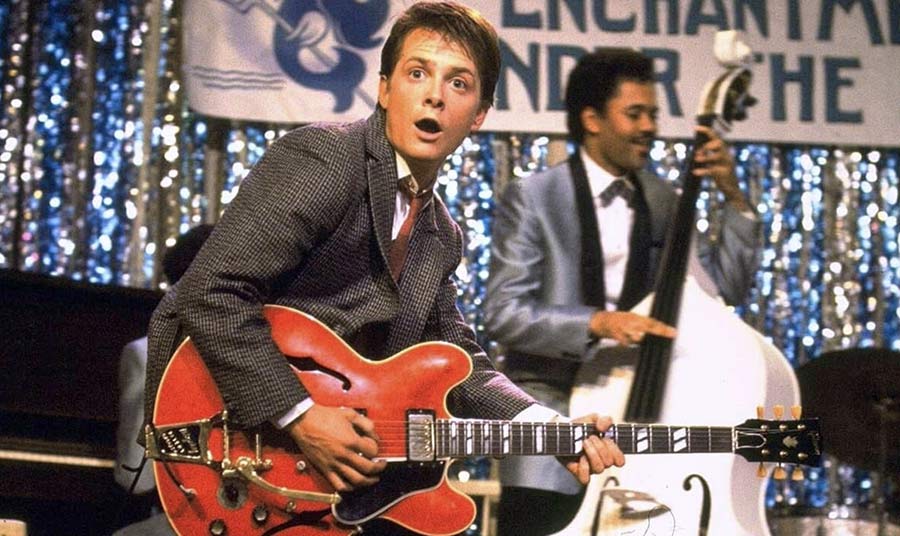
Frequently Asked Questions
Why is the Gibson ES-335 so popular?
It has been played by some of the best and most iconic players in history. It has a fantastic sound that you can’t replicate with any other instrument, and it looks amazing. Maybe a more appropriate question is “Why wouldn’t the ES-335 be so popular?”
What are 335 guitars good for?
The ES-335 can cover a lot of ground. Jazz, blues, country, fusion, rock, and even metal. Dave Grohl regularly plays his Trini Lopez semi-hollow, and Tom Morello of Rage Against the Machine has used his Ibanez Artstar Custom semi-hollow for his bone-crunching riffs. There is very little they can’t do.
How heavy are ES-335 guitars?
In general, a 335 is a lighter guitar than a Les Paul. Typically, they will weigh anywhere between 7 lbs to 8 lbs 11oz. This is on average, there are always outliers.
Which is bigger ES-335 or ES-339?
The ES-339 is simply a smaller version of the 335. It is approximately 2.5 inches shorter and 1.69 inches narrower at the widest point. That is the only difference.
What is the value of a vintage 335?
Vintage ES-335s are a serious investment. A good example from the most desirable years of 1958-1964 will cost you anywhere between $15,000-$100,000, with the celebrity-owned ones costing much more. They are still a fair bit cheaper than an original Les Paul, but certainly not for the faint-hearted. If you have a vintage Gibson ES-335 that you want to sell and would like a free appraisal, please get in touch with us at GearTalk.
Share your thoughts in our forum! 💬
👉 Introduce yourself and show off your ES-335 guitar and other gear.
Share this post with your friends using these one-click sharing options:
👉 Click here to share on Facebook.
👉 Click here to share on X.
👉 Click here to share on LinkedIn.
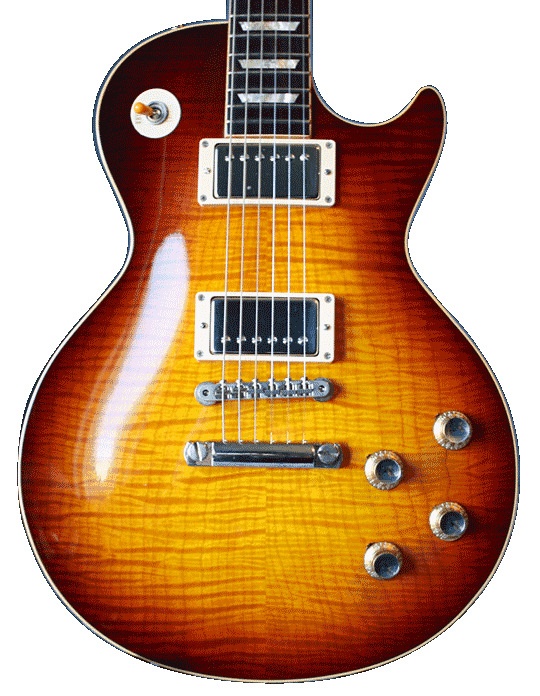
Get the latest reviews, guides and videos in your inbox.